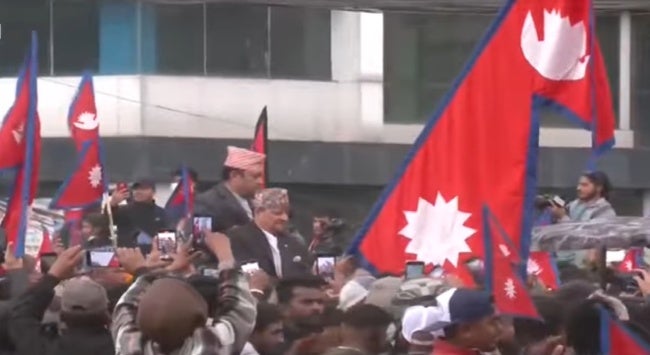Summary
Although there has been a recent surge in support for the monarchy in Nepal, the majority of Nepalese still favour a republican system. However, the recent political developments have raised concerns among pro-republican leaders. To ensure long-term political stability, improve governance and enhance the economic well-being of the citizens, the country’s leadership must take decisive and effective actions.
On 9 March 2025, thousands of Nepalese in the country’s capital, Kathmandu, welcomed former monarch, Gyanendra Shah, who landed in the city from Pokhara after attending pro-monarchy rallies in various parts of the country. According to the former King’s supporters, he was greeted by thousands of people during his visits to several districts of Nepal for almost two months before arriving in Kathmandu. In the capital, Shah was welcomed by flag-waving supporters, many of whom carried placards with slogans such as “We want our King back”, “Abolish federal republican system and reinstate the monarchy” and “The King and the country are dearer than our life”. The people gathered on the call by the pro-monarchy Rastriya Prajatantra Party (RPP) and like-minded outfits. Despite claims made by pro-Monarchy outfits, only 10,000 to 15,000 people participated in that rally.
Shah was crowned Nepal’s King in 2001 after his elder brother, Birendra Bir Bikram Shah, and his family were killed in a mass murder. In February 2005, accusing the country’s political parties of plunging the country into crisis by not holding elections or failing to end the civil war with Maoist rebels, Shah declared a state of emergency. The atrocities committed during the emergency triggered protests across the country, forcing the King to reinstate parliament that stripped him of most powers he had earlier. On 8 November 2006, the Seven Party Alliance, comprising Nepali Congress, Communist Party of Nepal – Unified Marxist Leninist (CPN-UML), Nepali Congress (Democratic), People’s Front, Nepal Workers and Peasants Party, Nepal Sadbhawna Party (Anandi Devi) and United Left Front, signed deal with the Maoists, ending civil war in the country. As part of the deal, the King would not have any state power. It was also agreed that all properties of the monarchy would be nationalised. In 2008, the newly elected constituent assembly abolished the monarchy, and Nepal was declared a federal democratic republic.
While the monarchy has ended, it continues to haunt Nepal’s politics. In 2020, after a series of pro-monarchy rallies across Nepal, Rastriya Shakti Nepal leader, Keshar Bahadur Bista, who led a rally in Kathmandu, called for the restoration of the monarchy to save the country. In 2021, pro-monarchy protestors demanding the return of the monarchy clashed with the police. Fuelling support for the monarchy, on the eve of Democracy Day on 19 February 2025, Shah stated, “It is necessary for all citizens to unite for the defence, progress and prosperity of the country…If we want to save the nation and maintain national unity, we call on all countrymen to support us for the prosperity and progress of the country.” Expressing concerns about the country’s politics, he further stated, “Politics that adopt a prohibitive approach does not strengthen democracy…The arrogance, personal interests and dogmatism of the parties and the opposition cannot make democracy dynamic.”
The leader of the opposition, Pushpa Kamal Dahal, accused the current government’s policies for the surge in pro-monarchy support. Earlier, addressing a meeting in Mahottari, Nepal’s Prime Minister K P Sharma Oli, dared Shah to constitute a political party and contest elections. Notably, both Dahal and Oli had previously secured support from the RPP. For instance, Oli’s CPN-UML and the RPP were partners in 2015, and the two parties allied in the 2022 general elections in some constituencies. In 2022, the RPP was a part of the Dahal-led government. At the same event in Mahottari , Nepali Congress President Sher Bahadur Deuba stated that Gyanendra’s “…missteps paved the way for republican system in the country…”.
Following the 9 March 2025 event, the Social Front Nepal, comprising the Communist Party of Nepal (Maoist Centre), the Communist Party of Nepal (Unified Socialist), the Janata Samajbadi Party, Nepal, and the Communist Party of Nepal, led by Netra Bikram Chand ‘Biplab’, have decided to hold counter-rally in Kathmandu on 28 March 2025.
One reason for a surge in pro-monarchy support is increasing disenchantment with the republic’s political leadership. Nepal has seen 13 different governments between 2008 and 2024. The country’s economy is not creating sufficient jobs for the country’s working-age population. According to the fourth Nepal Living Standard Survey report, published by the National Statistics Office in June 2024, the unemployment rate in Nepal climbed up to 12.6 percent in 2022-23 from 11.4 percent in 2017-18, a 1.2 percent rise in the five-year period. The economic situation at home is forcing many Nepali youths to migrate. In 2024, 856,422 Nepalese left the country for employment abroad. Of the total number, 769,890 were men and 96,197 were women. Corruption is also a concern. According to Transparency International’s report on corruption, in 2025, Nepal is ranked 107th out of 180 countries and territories in the Corruption Perceptions Index.
The monarchy is a regressive choice and should not be considered a political option. The responsibility now rests with Nepal’s current leadership to protect the republic from pro-monarchy forces. The leaders must focus on achieving long-term political stability, implementing reforms for inclusive economic growth that generate jobs for citizens, and ensuring a more transparent and accountable governance system. Failing to do so will only perpetuate the country’s ongoing challenges.
. . . . .
Dr Amit Ranjan is a Research Fellow at the Institute of South Asian Studies (ISAS), an autonomous research institute at the National University of Singapore (NUS). He can be contacted at isasar@nus.edu.sg. The author bears full responsibility for the facts cited and opinions expressed in this paper.
Pic Credit: ISAS-NUS
-
 More From :
More From :
-
 Tags :
Tags :
-
 Download PDF
Download PDF



